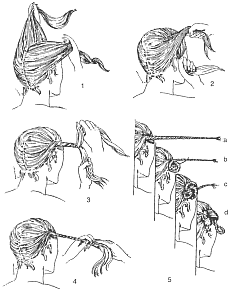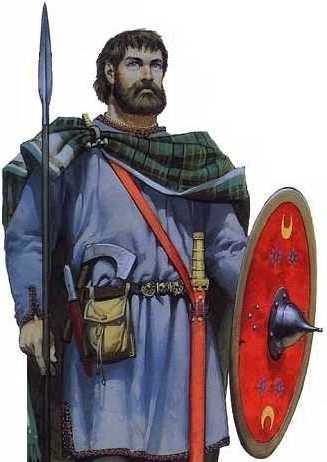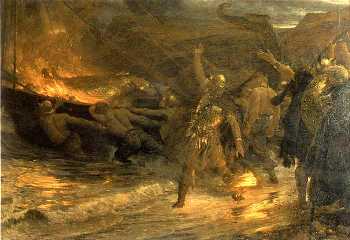In later periods the people started to use "turn-shoes"; pieces of leather were sewn together and then turned inside-out so that the seams were on the inside of the shoe, which wasn't as uncomfortable as it sounds, Germanic shoes did not had soles so people walked on nothing more than a piece of leather, not surprisingly shoes were worn out rather quickly and had to be replaced, though in later periods the bottoms of the shoes were made thicker for extra durability.
Women:
 To the right is a picture to give you an impression of what a Germanic woman looked like, the items you see have been found in a 5th century woman's grave in Zweelo in the Dutch province of Drenthe, the "princess of Zweelo" as she was called by archeologists was probably an important woman from a local Frisian or Saxon tribe, she carries a necklace of amber beads, a smaller necklace of glass beads, a beavertooth in a silver pendant, around her waist she carries a girdle of big glass beads and some bronze keys (that were often trusted to the lady of the house), on her wrist she carries a bronze bracelet and pins made of gilded iron close the linnen cloth on her shoulders.
To the right is a picture to give you an impression of what a Germanic woman looked like, the items you see have been found in a 5th century woman's grave in Zweelo in the Dutch province of Drenthe, the "princess of Zweelo" as she was called by archeologists was probably an important woman from a local Frisian or Saxon tribe, she carries a necklace of amber beads, a smaller necklace of glass beads, a beavertooth in a silver pendant, around her waist she carries a girdle of big glass beads and some bronze keys (that were often trusted to the lady of the house), on her wrist she carries a bronze bracelet and pins made of gilded iron close the linnen cloth on her shoulders.The position of women in Germanic society was in most places equal to men, though this depended on the time and the local morals.
The man was mostly the dominant person in the family while women were more important in spiritual matters, the Germans believed that women posessed magical powers because they were able to get pregnant and "create" new lives.
Because of this belief women played a dominant role in religion and some of them became a seer (Spákona) or a priestess (Gyðja), magic was also mainly performed by women and men often asked their women for advice.
When the man was not at home because he had to hunt, fight, travel, etc. it was the woman who stayed behind to look after the children and maintain the household, another interesting thing Tacitus mentions in his work is that Germanic women often supported their men during battles; they hurled insults at the enemy, sang battle songs, and promised their husbands sexual favours if they would win, Germanic warriors sometimes won a battle purely because of their women's support.
From Tacitus "Germania":
"8. In history we find, that some armies already yielding and ready to fly, have been by the women restored, through their inflexible importunity and entreaty, presenting their breasts, and showing their impending captivity; an evil to the Germans then by far most dreadful when it befalls their women. So that the spirit of such cities as amongst their hostages are enjoined to send their damsels of quality, is always engaged more effectually than that of others. They even believe them endowed with something celestial and the spirit of prophecy. Neither do they disdain to consult them, nor neglect the responses which they return."
It appears that in the early Germanic culture men and women were equal and that there were even women who became warriors; in West Heslerton (England) an early Saxon settlement and burial place has been discovered where the body of a female warrior was found who was buried with two spears and a man who was buried with broches and beads.
After the Christianization of Europe the role of women in society became less important, in the Middle Ages women were seen as unfaithful liars whose only task was giving birth to children, taking care of them, and making sure that there was dinner on the table when the husband came back home.
Fortunately there has been some secularisation in the Christian church for the last couple of centuries that allowed some equalizing and emancipation.
Nowadays the position of women in this world has improved the most in the Germanic countries, so it can be said that the intolerance towards women was never truly accepted there.
Morals:

 The average day of a German consisted of getting up early (when it got light outside), eating his meal and going to work, for a man this could either be hunting, fishing, farming, herding, making weapons or tools, etc. women took care of herding, foraging, baking bread, taking care of the children, weaving, and many other things, when the people had time left they gossiped, socialized, created art, made beer, drank beer, repaired things, etc.
The average day of a German consisted of getting up early (when it got light outside), eating his meal and going to work, for a man this could either be hunting, fishing, farming, herding, making weapons or tools, etc. women took care of herding, foraging, baking bread, taking care of the children, weaving, and many other things, when the people had time left they gossiped, socialized, created art, made beer, drank beer, repaired things, etc. The hair styles that the Germans used were variable, there was no such thing as a "common hairstyle", however; it is known that Thralls (slaves) had very short hair and that the average man had his hair a little longer, (shoulder length) many men also carried moustaches and beards but long beards were mostly worn by the more important persons because beards and mustaches were a sign of status among our ancestors.
The hair styles that the Germans used were variable, there was no such thing as a "common hairstyle", however; it is known that Thralls (slaves) had very short hair and that the average man had his hair a little longer, (shoulder length) many men also carried moustaches and beards but long beards were mostly worn by the more important persons because beards and mustaches were a sign of status among our ancestors. Another peculiar hair style was the "Suebian knot"; one combed his hair to the right side of the head, twisted it together, and laid a knot in it, especially the Suebians after whom it was named used this hair style.
Another peculiar hair style was the "Suebian knot"; one combed his hair to the right side of the head, twisted it together, and laid a knot in it, especially the Suebians after whom it was named used this hair style. The clothing that was used were mainly tunics for men and dresses or simple aprons for women, the Germans used a wide variety of clothing so it is difficult to be exact about this, they also wore pantaloons and women sometimes wrapped scarfs around their necks, woollen cloaks were also worn around the shoulders that were held together with beautifully decorated pins (called "fibulae" in Latin), this cloak served the same purpose as our modern coats; namely to keep the body warm, I think it is save to assume that this was the most common clothing style used.
The clothing that was used were mainly tunics for men and dresses or simple aprons for women, the Germans used a wide variety of clothing so it is difficult to be exact about this, they also wore pantaloons and women sometimes wrapped scarfs around their necks, woollen cloaks were also worn around the shoulders that were held together with beautifully decorated pins (called "fibulae" in Latin), this cloak served the same purpose as our modern coats; namely to keep the body warm, I think it is save to assume that this was the most common clothing style used. Shoes were mostly made of leather and had much in common with the sandals that the Romans and Celts used, to the right you can see two shoes that have been found in the Netherlands:
Shoes were mostly made of leather and had much in common with the sandals that the Romans and Celts used, to the right you can see two shoes that have been found in the Netherlands: Hávamál:
Hávamál: Wedding and divorce:
Wedding and divorce: